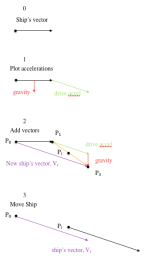So I was looking at the basic MOVEMENT rules and attempting to change the scales ... you know, what if a turn was 100 seconds instead of 1000 seconds or 100 minutes. That got me to trying to figure out the length of a 1G THRUST vector (you know, how far will a thrust of 1G for 1 "turn" change the movement vector.
That led me to discover what others before me must have discovered (after 40+ years, I cannot be the first to observe this).
So let us set 1G at 10 m/s/s for simplicity of math and start with the 1000 second turn common in most CT Movement/Combat Rules (LBB2/LBB5):
LBB2:81 states a 1G Thrust will produce a 10,000 km (100 mm) vector [which is correct for final VELOCITY, but doubles the actual DISPLACEMENT].
MAYDAY allows a 1G thrust to produce a 300,000 km (1 hex) vector [which is correct for final VELOCITY, but doubles the actual DISPLACEMENT].
So let's talk about it ... (I know it inspired lots of immediate thoughts in my mind).
That led me to discover what others before me must have discovered (after 40+ years, I cannot be the first to observe this).
So let us set 1G at 10 m/s/s for simplicity of math and start with the 1000 second turn common in most CT Movement/Combat Rules (LBB2/LBB5):
- 1000 seconds at 10 m/s/s = 10 x 1000 = 10,000 m/s velocity = +10 km/s = 10,000 km/turn change in velocity
- 1000 seconds at 10 m/s/s = 0.5 x 10 x 1000^2 = 5,000,000 meters = +5,000 km = 5,000 km/turn change in displacement
- 6000 seconds at 10 m/s/s = 10 x 6000 = 60,000 m/s velocity = +60 km/s = 360,000 km/turn change in velocity
- 6000 seconds at 10 m/s/s = 0.5 x 10 x 6000^2 = 180,000,000 meters = +180,000 km = 180,000 km/turn change in displacement
LBB2:81 states a 1G Thrust will produce a 10,000 km (100 mm) vector [which is correct for final VELOCITY, but doubles the actual DISPLACEMENT].
MAYDAY allows a 1G thrust to produce a 300,000 km (1 hex) vector [which is correct for final VELOCITY, but doubles the actual DISPLACEMENT].
So let's talk about it ... (I know it inspired lots of immediate thoughts in my mind).
Last edited:

